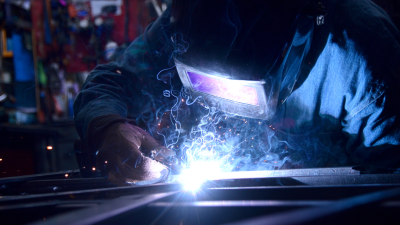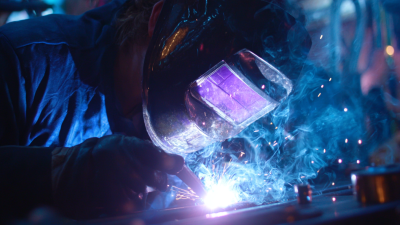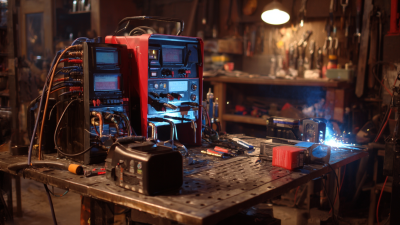Ultimate Guide to Mobile Welding Techniques for Every DIY Enthusiast
In the realm of DIY projects, mobile welding has emerged as a pivotal skill for enthusiasts seeking versatility and efficiency. With the growing trend of home improvement and custom fabrication, industry reports indicate that the mobile welding market is expected to exceed $4 billion by 2025, highlighting the increasing demand for portable welding solutions. As hobbyists and professionals alike embrace the flexibility of mobile welding techniques, mastering this craft can open up a plethora of opportunities for creative woodworking, metal art, and repair work. This ultimate guide aims to illuminate the various techniques and tools essential for mobile welding, empowering DIY enthusiasts to take their projects on the road and achieve professional-quality results, regardless of their location. In an age where mobility and skill convergence are key, understanding the nuances of mobile welding can significantly enhance the DIY experience.

Understanding the Basics of Mobile Welding for DIY Projects
Mobile welding has become an essential skill for DIY enthusiasts, allowing you to tackle projects with flexibility and convenience. Understanding the basics of mobile welding starts with familiarizing yourself with the different types of welding processes, such as MIG, TIG, and Stick welding. Each method has its unique applications and advantages, making it crucial to select the right technique for specific tasks. MIG welding is often favored for its ease of use and speed, whereas TIG welding is preferred for producing high-quality, precise welds.
Safety is paramount when engaging in mobile welding. As a DIY enthusiast, you must equip yourself with the proper protective gear, including a welding helmet, gloves, and protective clothing, to safeguard against sparks and harmful fumes. Additionally, understanding the importance of ventilation in your work area can prevent health risks associated with welding fumes. By mastering these foundational aspects of mobile welding, you’ll not only enhance your skill set but also gain the confidence to embark on various DIY projects, from metal furniture to vehicle repairs, with professional results.
Mobile Welding Techniques Popularity Among DIY Enthusiasts
Essential Tools and Equipment for Effective Mobile Welding
When it comes to mobile welding, having the right tools and equipment is crucial for any DIY enthusiast aiming for effective results. Start with a reliable welding machine; options like MIG, TIG, or stick welders vary based on your project needs. A portable and lightweight welder will make transportation easier and still provide the power needed for various materials. Don’t forget to invest in a quality helmet with auto-darkening features for hands-free operation, ensuring safety and comfort while you work.
Tips: Always check the power requirement of your welder against your location's supply. If you're often working in remote areas, consider a generator to ensure you have a reliable power source.
Additionally, you’ll need a sturdy work surface and clamps to hold your materials in place. A well-organized tool kit with essential items like gloves, wire brushes, and safety glasses will also keep you safe and efficient. Remember that proper ventilation during the welding process is key; if you’re in a confined space, use fans or extractors to ensure airflow and reduce fume exposure.
Tips: Regularly maintain your equipment to extend its lifespan, and always keep an eye on your surroundings to avoid accidents or damage to your devices.
Safety Protocols Every DIY Welder Should Follow
When engaging in mobile welding, adhering to safety protocols is crucial for every DIY enthusiast. Hot work, which includes welding activities, poses risks associated with open flames, sparks, and high temperatures, which can ignite flammable materials. According to industry standards, having a dedicated hot work permit is essential when conducting such activities. This ensures that all potential hazards are assessed and mitigated, reinforcing the importance of a well-prepared environment to prevent accidents during welding.
Furthermore, personal protective equipment (PPE) plays a vital role in safeguarding welders. Operators should always wear appropriate gear, which includes gloves, long-sleeve clothing, and helmets with suitable face shields. Employing additional safety measures, such as laser safety glasses for specific tasks, enhances protection against harmful rays and sparks. A report from a safety standards organization indicates that proper PPE can reduce the risk of injury by up to 70%, emphasizing the necessity of compliance with safety protocols in the welding field. As DIY welding gains popularity, understanding and implementing these safety measures should be a priority for anyone looking to take on welding projects.

Common Techniques and Their Applications in Mobile Welding
Mobile welding offers a variety of techniques that cater to different projects and materials. One of the most common methods is MIG (Metal Inert Gas) welding, which is ideal for DIY enthusiasts due to its ease of use and versatility. MIG welding uses a continuous wire feed, making it suitable for both thin sheet metals and thicker workpieces. This technique is perfect for tasks like automotive repairs and fabricating metal structures, allowing welders to achieve clean and strong welds efficiently.
Another frequently used technique in mobile welding is TIG (Tungsten Inert Gas) welding. Although it requires more skill than MIG welding, TIG is renowned for producing high-quality, precise welds on stainless steel, aluminum, and other metals. This method is particularly beneficial for intricate projects such as artistic metal sculptures or thin-walled pipes, where aesthetics and strength are crucial. Finally, stick welding (SMAW) is also commonplace, especially for outdoor or large-scale projects, owing to its portability and ability to work in challenging conditions. Each of these techniques has its unique advantages, making them essential tools for every DIY welding enthusiast.

Tips for Improving Your Mobile Welding Skills on the Go
When it comes to mobile welding, improving your skills requires both technique and adaptability. According to the American Welding Society, the demand for skilled welders is projected to rise by 6% by 2029, underscoring the importance of honing your craft. For DIY enthusiasts, practicing in diverse environments can significantly enhance your proficiency. One effective way to build muscle memory is to engage in small welding projects frequently. Simple tasks such as metal repairs or creating custom furniture can provide a hands-on learning experience while allowing you to experiment with different welding techniques.
Moreover, investing in portable welding equipment can streamline your process on the go. The National Center for Welding Education and Training reports that incorporating advancements in mobile welding technology, such as inverter welders and all-in-one systems, can help DIYers manage their projects with greater efficiency and flexibility. Additionally, familiarizing yourself with safety protocols and maintenance procedures will not only extend the life of your tools but also ensure a safer working environment. Taking the time to learn about these essential aspects can elevate your mobile welding skills, enabling you to tackle a wide range of projects confidently.
Related Posts
-

The Science Behind Welding Metal Techniques for Stronger Fabrications
-

Ultimate Guide to Starting Your Own Mobile Welding Business in 2023
-

Understanding the Essential Components of MIG Welding Equipment for Beginners
-

Revolutionizing Industrial Manufacturing: The Future of Seam Welding Machines in Modern Applications
-

Unlocking the Future: How Automotive Welding Technologies Are Revolutionizing Vehicle Manufacturing

Contact us
Please fill out the enquiry form, and our dedicated team will promptly attend to your request